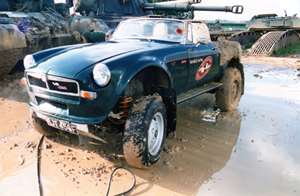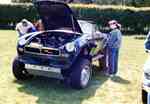Would you drive your immaculate MGB through a ploughed field? Would you immerse it in mud up to the doors? This is exactly what the MGOC invited us to do on the tank testing course at The Imperial War Museum, Duxford. Fortunately at Maidstone Sports Cars we were equipped with a vehicle more than capable of responding to this challenge. Maidstone Sports Cars specialises in the restoration, servicing and upgrading of all types of classic and modern sports cars.
As a company Maidstone Sports Cars attends numerous MG and classic car shows to promote our business and exhibit vehicles we have restored and built. Planning show visits had become increasingly difficult because completed vehicles were being sold so quickly that often we had nothing to take and show. The decision was taken to build the ultimate show car demonstrating the quality and variety of work we carry out at Maidstone Sports Cars.
The design brief was to create a vehicle based on the MGB which would be pleasant to drive on the road but would also have amazing 'off road' capabilities. The car would have to be immaculately finished and engineered to a very high standard. The project was prompted by the acquisition of a burnt out rolling chassis from a 1988 Range Rover. Although the engine was missing, the gearbox, a ZF 4 speed automatic, was intact. The ideas began to flow. A very badly damaged MGB Roadster shell of American specification which had been abandoned in our compound was earmarked for the body.
The first step was to cut the Range Rover chassis and make it the same wheel base as the MGB, ie 92 inches. The MGB body was then bought into the workshop where extensive modifications took place. These involved cutting out the front chassis rails, under-pan rails, floor pan and gearbox tunnel so that the body could be offered to the chassis. After much thought and discussion it was decided to mount the body using the strongest points of the MGB namely the 'A' and 'B' posts. These became the main mounting points and using the mounts left on the Range Rover chassis further structural connections were made. The body is actually mounted to the chassis in ten separate places each with a rubber mounting pad.
The body was then reconstructed with a new floor pan, gearbox tunnel and a rear box section to cover the rear radius arms. Complete new inner wing sections and front panels were also fitted. Bracing struts and reinforcement bars were incorporated into the MGB bodyshell. American specification doors were used, including reinforcement bars, but the scuttle was changed to one of British specification. A Sebring body panel kit was purchased and a great deal of care and skill went into the accurate fitting of these panels. The fuel tank was to be mounted on the MGB bodywork therefore the unnecessary rear section of the Range Rover chassis was removed at this stage of the proceedings.
We were able to make some improvements on a basic MGB, the first was to fit the battery in the boot and run the wiring through the sill section. (I think many B owners would appreciate this.) A special tuning front spoiler was fitted and flared into the fibre glass wings. The body was then painted in Rover Metallic British Racing Green, a colour which we think enhances the flared arches and rounded shape. While the body was off the chassis being painted, the shortened chassis was dismantled and shot blasted before being sprayed in two pack black. All components were similarly treated. Every nut and bolt was zinc plated. The rolling chassis was then rebuilt using new bushes.
The braking system incorporated a standard MGB master cylinder and Servo linked by copper brake pipes and twin stainless steel flexibles by Aeroquip to the standard Range Rover four pot calipers at the front and to the single pot calipers at the rear. The handbrake utilised a handle from an MGB linked through an MG TF handbrake cable to the single centre mounted brake drum and has proved to be very effective. Bleeding the braking system turned out to be a nightmare, with the fluid having to pass through single lines into T' pieces, twin flexibles and four pot calipers with twin bleed nipples. In operation, the brakes have been very effective with excellent stopping capabilities despite a somewhat heavy pedal. The steering presented a few problems with the Range Rover steering box being attached by a double U/J and the Range Rover steering shaft to a standard MGB steering column. Fortunately all the splines were compatible. The suspension is pure Range Rover. At one point we did remove the self levelling strut at the rear but after road tests it was found that it still was necessary and so was refitted.
The car handles surprisingly well and has not got that soggy wallowy feeling of the Range Rover, probably due to the lighter load of the MGB body. Antiroll bars were deemed unnecessary.
The automatic transmission and transfer box were fitted to the chassis and a shortened propshaft used to compensate for the chassis changes.
The completed painted body shell was lowered onto the completed rolling chassis and secured to its mounting positions. The Rover 3.5 V8 engine we acquired needed a complete rebuild and this we did using new pistons, rings, oil pump etc. We were fortunate to find a pair of brand new SU carburettors, manifolds and linkage from a 1992 Land Rover. These were fitted and our own linkages and kick down cable for the automatic transmission connected. The engine was then installed. Part of the design brief was to keep as many standard MGB parts as possible therefore we still used standard pedal box, heater box, servo assembly etc, so that when the engine bay was completed it still resembled a normal MGB V8 road car.
Much discussion took place before we decided on the correct positions for such things as radiator, power steering pump, brake systems, etc. A large capacity radiator was specially made using shortened Range Rover ends and a special core. A Kenlowe electric cooling fan was installed. This system proved very efficient, especially with the large air space under the bonnet, created by the use of a large grille and apertures arranged underneath. The transmission cooler was positioned in front of the radiator and in line with the spoiler cooling vent. The petrol tank used was normal MGB modified by removing the front and rebuilding with a smaller flat panel, this then lined up with the chassis .This looks particularly good when viewed from the rear. This was also quite convenient as all the mounting holes could be still be retained and the original tank sender unit would fit as normal. The tank was linked to a Facet fuel pump and a filter king fuel regulator via braided stainless steel pipes.
The wiring loom is MGB. It is linked via a relay to the automatic gear change to isolate starting except in park or neutral. The exhaust system was fabricated using the existing Range Rover EFI manifolds and downpipes linked to our own single pipe system running through two Rover Vitesse boxes. The exhaust note is distinctive but not over loud and does not attract too much attention.
The interior presented few problems and looks at first sight to be standard but on close inspection the modifications to the bodyshell have led to a unique carpet set in green with tan piping.
The seats finished in tan Connolly hide, as are the door panels, are of American specification and are solid mounted. The tan with green piping has certainly been an eye catcher and the interior is credit to our upholsterer. A new smaller radio console was made in order to clear the high/low gear lever. A standard MGB dashboard was fitted, the only alteration being the re-siting of the ignition switch in the overdrive switch position. The rev counter was recalibrated to V8. The speedo is mated to the auto box by an MG Midget speedo cable. Extensive sound deadening and insulation was applied to the gearbox tunnel and floor to dampen down any road noise.
One feature of the vehicle which contributes to its aggressive stance is the skid plate constructed from aluminium chequer plate. The running boards of the same chequer plate and the mud flaps were added at a later date when during cross country trials we usually ended up with more mud than car.
The vehicle's appearance at the MOT station was met with disbelief, however the car sailed through with flying colours and is fully road legal.
We experienced a few teething troubles, the main one being that we were using the wrong coil and this persisted in melting the points in the distributor. This was quickly sorted out and since then the car has been remarkably reliable. The reaction of people who see the car on the road is quite amazing. We have often had people stand and clap or cheer, obviously enthusiasts who recognise something good when they see it! Of course there are those who think we have ruined an MGB but everyone has a right to their own opinion.
The vehicle's on-road performance is surprisingly good with superb acceleration and the ability to cruise at 80 mph at 2,200 rpm - the ultimate lazy cruiser. In traffic the car is a joy to drive with the automatic transmission and power steering making life easy. As for off-road performance -anyone who witnessed its display at MGOC 'Sky's the Limit' picnic at Dux-ford will vouch for its unstopability. It did however take a week to clean all the mud off!
Our original aim to produce a show car that nobody would wish to buy has also been proved wrong as many offers have been received for this unique vehicle.
The vehicle was subsequently featured in the Daily Telegraph motoring section and was then road tested on the BBC Top Gear program(see video link) where it was complimented on being beautifully engineered!



